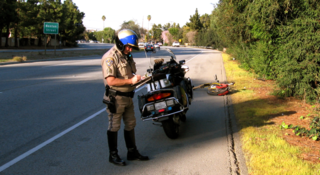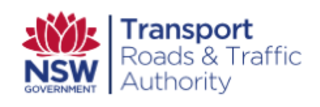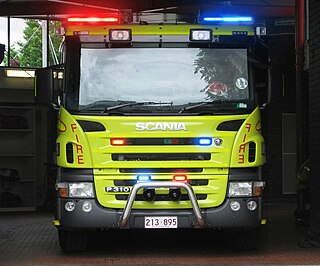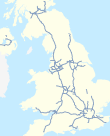
A highway patrol is a police unit, detail, or law enforcement agency created primarily for the purpose of overseeing and enforcing traffic safety compliance on roads and highways within a jurisdiction. They are also referred to in many countries as traffic police, although in other countries this term is more commonly used to refer to foot officers on point duty who control traffic at junctions.

A variable-message sign or message board, often abbreviated VMS, VMB, CMS, or DMS, and in the UK known as a matrix sign, is an electronic traffic sign often used on roadways to give travelers information about special events. Such signs warn of traffic congestion, accidents, incidents such as terrorist attacks, AMBER/Silver/Blue Alerts, roadwork zones, or speed limits on a specific highway segment. In urban areas, VMS are used within parking guidance and information systems to guide drivers to available car parking spaces. They may also ask vehicles to take alternative routes, limit travel speed, warn of duration and location of the incidents, inform of the traffic conditions, or display general public safety messages.
National Highways (NH), formerly the Highways Agency and later Highways England, is a government-owned company charged with operating, maintaining and improving motorways and major A roads in England. It also sets highways standards used by all four UK administrations, through the Design Manual for Roads and Bridges. Within England, it operates information services through the provision of on-road signage and its Traffic England website, provides traffic officers to deal with incidents on its network, and manages the delivery of improvement schemes to the network.

A parking enforcement officer (PEO), traffic warden, parking inspector/parking officer, or civil enforcement officer is a member of a traffic control agency, local government, or police force who issues tickets for parking violations. The term parking attendant is sometimes considered a synonym but sometimes used to refer to the different profession of parking lot attendant.

A police car is a ground vehicle used by police and law enforcement for transportation during patrols and responses to calls for service. A type of emergency vehicle, police cars are used by police officers to patrol a beat, quickly reach incident scenes, and transport and temporarily detain suspects, all while establishing a police presence and providing visible crime deterrence.

The Roads & Traffic Authority (RTA) was an agency of the Government of New South Wales responsible for major road infrastructure, licensing of drivers, and registration of motor vehicles. The RTA directly managed state roads and provided funding to local councils for regional and local roads. In addition, with assistance from the federal government, the RTA also managed the NSW national highway system. The agency was abolished in 2011 and replaced by Roads & Maritime Services.

Traffic police are police officers, units, and agencies who enforce traffic laws and manage traffic. Traffic police include police who patrol highways, direct traffic, and address traffic infractions. They may be a separate agency from a main police agency, a unit or division within a police agency, or a type of assignment issued to officers; they can also be part of a transportation authority or highway authority.

A motor vehicle has lighting and signaling devices mounted to or integrated into its front, rear, sides, and, in some cases, top. Various devices have the dual function of illuminating the road ahead for the driver, and making the vehicle visible to others, with indications to them of turning, slowing or stopping, etc., with lights also indicating the size of some large vehicles.

Vehicle and Operator Services Agency (VOSA) was an executive agency granted trading fund status in the United Kingdom sponsored by the Department for Transport of the United Kingdom Government.

Emergency vehicle lighting, also known as simply emergency lighting or emergency lights, is a type of vehicle lighting used to visually announce a vehicle's presence to other road users. A sub-type of emergency vehicle equipment, emergency vehicle lighting is generally used by emergency vehicles and other authorized vehicles in a variety of colors.

Emergency vehicle equipment is any equipment fitted to, or carried by, an emergency vehicle, other than the equipment that a standard non-emergency vehicle is fitted with.
A roads policing unit (RPU), or a similarly named unit in some forces, is the specialist road traffic police unit of a British police force.
Driving in the United Kingdom is governed by various legal powers and in some cases is subject to the passing of a driving test. The government produces a Highway Code that details the requirements for all road users, including drivers. Unlike most other countries in the world, UK traffic drives on the left.

Police in the United Kingdom use a wide range of operational vehicles, including compact cars, powerful estates and armoured police carriers. The main uses are patrol, response, tactical pursuit, and public order policing. Other vehicles used by British police include motorcycles, aircraft, and boats.

The Punjab Highway Patrol serves as the safe highways police for all Provincial Highways of Punjab. The PHP patrol the roads to maintain safe highways and prevent crimes from taking place, especially in rural regions of Punjab. Recently, in many districts, some of the patrolling units have also been given the responsibility for imposing tickets for traffic violations.

National Police Corps, colloquially in English as Dutch National Police or National Police Force, is divided in ten regional units, two national units, the police academy, police services center, and national dispatch center cooperation. The law-enforcement purposes of these agencies are the investigation of suspected criminal activity, referral of the results of investigations to the courts, and the temporary detention of suspected criminals pending judicial action. Law enforcement agencies, to varying degrees at different levels of government and in different agencies, are also commonly charged with the responsibilities of deterring criminal activity and preventing the successful commission of crimes in progress. The police commissioner in the Netherlands is Janny Knol since March 1, 2024.

A move over law is a law which requires motorists to move over and change lanes to give safe clearance to law enforcement officers, firefighters, ambulances, utility workers, and in some cases, tow-truck drivers and disabled vehicles. In the past, Canada and United States have used this term to apply to two different concepts; however, this is beginning to change as Canadian provinces have begun expanding the scope of their move over laws.

The National Highways & Motorway Police, abbreviated NHMP, is a police force in Pakistan that is responsible for enforcement of traffic and safety laws, security and recovery on Pakistan's National Highways and Motorway network. NHMP use SUVs, cars and heavy motorbikes for patrolling purposes and use speed cameras for enforcing speed limits.

Roads and Maritime Services was an agency of the New South Wales Government responsible for building and maintaining road infrastructure and managing the day-to-day compliance and safety for roads and waterways.

Welsh Government traffic officers are civilian staff employed by the trunk road agents on behalf of the Welsh Government as a means to ease traffic congestion on major trunk roads in Wales. Their role and powers are similar to their English counterparts working for National Highways, the National Highways traffic officers.



















